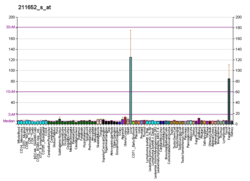Protéine de liaison au lipopolysaccharide
La protéine de liaison au lipopolysaccharide (ou Lipopolysaccharide Binding Protein) est une protéine qui, chez l’homme, est codée par le gène LBP[5] situé sur le chromosome 20 humain.
La LBP est une protéine soluble de phase aiguë qui se lie au lipopolysaccharide bactérien (ou LPS) pour induire des réponses immunitaires en présentant le LPS à d'importants récepteurs de reconnaissance du motif de la surface cellulaire appelés CD14 et TLR4[6]. Modèle:PBB Summary
La protéine codée par ce gène est impliquée dans la réponse immunologique en phase aiguë aux infections bactériennes à Gram négatif. Les bactéries à Gram négatif contiennent un glycolipide, un lipopolysaccharide (LPS), sur leur paroi cellulaire externe. Avec la protéine augmentant la perméabilité bactéricide (BPI ou batericidal permeability-increasing protein), la protéine codée se lie au LPS et interagit avec le récepteur CD14, jouant probablement un rôle dans la régulation des réponses des monocytes dépendant du LPS. Des études chez la souris suggèrent que la protéine codée est nécessaire à la réponse rapide du LPS en phase aiguë, mais pas à la clairance du LPS de la circulation. Cette protéine fait partie d'une famille de protéines structurellement et fonctionnellement liées, notamment la BPI, la protéine de transfert de cholestérol ester plasmatique (CETP) et la protéine de transfert de phospholipides (PLTP). Enfin, ce gène se trouve sur le chromosome 20, immédiatement en aval du gène BPI.
Interactions
Il a été démontré que la protéine liant les lipopolysaccharides interagissait avec CD14,TLR2, TLR4 et le co-récepteur MD-2[7],[8],[9].
Notes et références
Bibliographie
- RR. Schumann, SR. Leong, GW. Flaggs et al., Structure and function of lipopolysaccharide binding protein in Science 249 (4975), 1990 : 1429–31.
- CG. Wilde, J.J. Seilhamer, M. McGrogan et al., Bactericidal/permeability-increasing protein and lipopolysaccharide (LPS)-binding protein. LPS binding properties and effects on LPS-mediated cell activation, in J. Biol. Chem. 269 (26), 1994 : 17411–17416. .
- CT. Park, SD. Wright, Plasma lipopolysaccharide-binding protein is found associated with a particle containing apolipoprotein A-I, phospholipid, and factor H-related proteins in J. Biol. Chem. 271 (30), 1996. .
- A. Nanbo, H. Nishimura, S. Nagasawa, Lipopolysaccharide binding protein from normal human plasma purified with high efficiency in Protein Expr. Purif. 10 (1), 1997 : 55–60. .
- J.A. Hubacek, C. Büchler, C. Aslanidis, G. Schmitz, The genomic organization of the genes for human lipopolysaccharide binding protein (LBP) and bactericidal permeability increasing protein (BPI) is highly conserved in Biochem. Biophys. Res. Commun. 236 (2), 1997 : 427–430. .
- RS. Jack, X. Fan, M. Bernheiden et al., Lipopolysaccharide-binding protein is required to combat a murine gram-negative bacterial infection in Nature 389 (6652), 1997 : 742–745. .
- CJ. Kirschning, J. Au-Young, N. Lamping et al., Similar organization of the lipopolysaccharide-binding protein (LBP) and phospholipid transfer protein (PLTP) genes suggests a common gene family of lipid-binding proteins in Genomics 46 (3), 1998 : 416–25. .
- L.J. Beamer, SF. Carroll, D. Eisenberg, The BPI/LBP family of proteins: a structural analysis of conserved regions in Protein Sci. 7 (4), 1998 : 906–914. .
- M. Sato, Y. Saeki, K. Tanaka, Y. Kaneda, Ribosome-associated protein LBP/p40 binds to S21 protein of 40S ribosome: analysis using a yeast two-hybrid system, in Biochem. Biophys. Res. Commun. 256 (2), 1999 : 385–390. .
- AC. Vreugdenhil, MA. Dentener, AM. Snoek et al., Lipopolysaccharide binding protein and serum amyloid A secretion by human intestinal epithelial cells during the acute phase response in Journal of Immunology 163 (5), 1999 : 2792–2798. .
- C.J. Vesy, R. L. Kitchens, G. Wolfbauer et al., Lipopolysaccharide-Binding Protein and Phospholipid Transfer Protein Release Lipopolysaccharides from Gram-Negative Bacterial Membranes, in Infect. Immun. 68 (5), 2000 : 2410–2417. .
- M.O. Labéta, K. Vidal, JE. Nores et al., Innate Recognition of Bacteria in Human Milk Is Mediated by a Milk-Derived Highly Expressed Pattern Recognition Receptor, Soluble Cd14 in J. Exp. Med. 191 (10), 2000 : 1807–1812. .
- M.A. Dentener, A. C. Vreugdenhil, P.H. Hoet et al., Production of the acute-phase protein lipopolysaccharide-binding protein by respiratory type II epithelial cells: implications for local defense to bacterial endotoxins in Am. J. Respir. Cell Mol. Biol. 23 (2), 2000 : 146–153. .
- I. Nagaoka, S. Hirota, F. Niyonsaba et al., Cathelicidin family of antibacterial peptides CAP18 and CAP11 inhibit the expression of TNF-alpha by blocking the binding of LPS to CD14(+) cells in Journal of Immunology 167 (6), 2001 : 3329–3338. .
- T. Gutsmann, M. Müller, SF. Carroll et al., Dual Role of Lipopolysaccharide (LPS)-Binding Protein in Neutralization of LPS and Enhancement of LPS-Induced Activation of Mononuclear Cells in Infect. Immun. 69 (11), 2001 : 6942–6950. .
- N. Iovine, J. Eastvold, P. Elsbach et al., The carboxyl-terminal domain of closely related endotoxin-binding proteins determines the target of protein-lipopolysaccharide complexes in J. Biol. Chem. 277 (10), 2002 : 7970–7978. .
- P. Deloukas, L. H. Matthews, J. Ashurst et al., The DNA sequence and comparative analysis of human chromosome 20 in Nature 414 (6866), 2002 : 865–871. .
- J. Kaden, P. Zwerenz, HG. Lambrecht, R. Dostatni, Lipopolysaccharide-binding protein as a new and reliable infection marker after kidney transplantation in Transpl. Int. 15 (4), 2002 : 163–172. .
- O. Reyes, MG. Vallespi, HE. Garay et al., Identification of single amino acid residues essential for the binding of lipopolysaccharide (LPS) to LPS binding protein (LBP) residues 86-99 by using an Ala-scanning library in J. Pept. Sci. 8 (4), 2002 : 144–150. .
Liens externes
- Ressources relatives à la santé :
- (en) MeSH lipopolysaccharide-binding+protein
Cet article incorpore le texte de la National Library of Medicine des États-Unis , qui est du domaine public .









